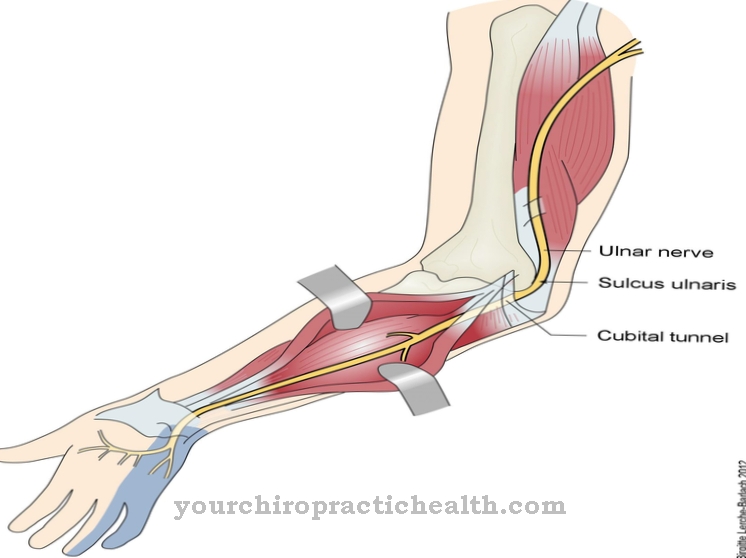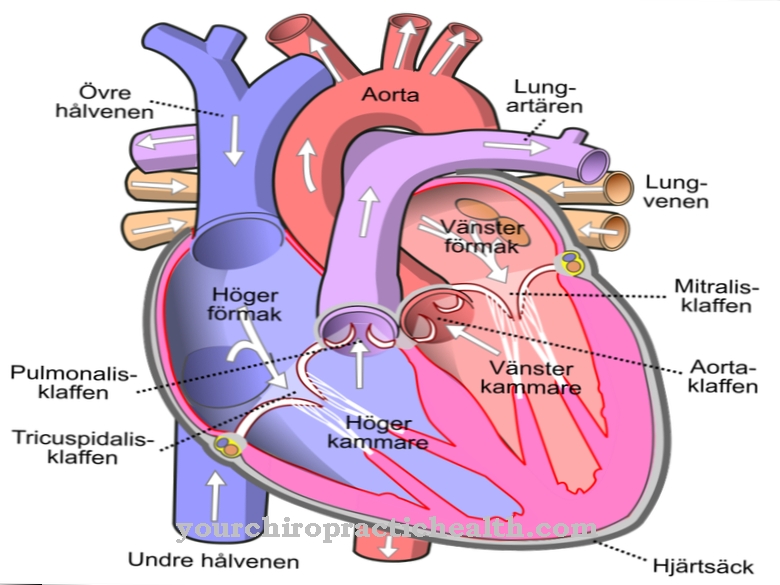The Mesenchyme envelops the fruit of the abdomen as embryonic connective tissue with a protective cover and is relevant for morphogenesis. Connective tissue, muscle, blood and fat cells, among other things, differentiate from multipotent mesenchymal cells during embryogenesis. Because of the high rate of division, mesenchyme is susceptible to tumors.
What is the mesenchyme?
During the embryonic period, the human supporting and filling tissue develops. This tissue is also known as embryonic connective tissue. It develops from polypent cells. The polypotency allows the cells to differentiate into almost all cell types of the three germ layers.
In addition to the gelatinous connective tissue, the so-called mesenchyme is created. This is connective tissue from the mesoderm, which later forms the loose, tight and reticular connective tissue. In addition to the types of connective tissue, bones and cartilage develop from the mesenchyme. The smooth muscles and the heart muscle are also dependent on the mesenchyme. The tissue also forms the basis for the development of the kidneys and adrenal cortex.
In addition, the cells of the mesenchyme are involved in the formation of the blood-forming system and the development of blood and lymph vessels. The development processes take place through differentiation and determination. The determination specifies the development program that all daughter cells of a poli- or omnipotent cell have to go through later. The cell development from the mesenchyme is therefore a specialization.
Anatomy & structure
Histologically, the mesenchyme is a certain type of tissue that has arisen from the stem cell cluster of the mesoderm or cotyledon. Mesenchyme contains star-shaped branched cells.
These cells are also called mesenchymal stem cells, mesenchymal stromal cells or mesenchymal cells.The individual cells of the mesenchyme are mechanically and interactively connected to one another through cytoplasmic processes. Mesenchymal stem cells have a relatively high rate of division, or mitotic rate. They are multipotent cells. This means that they are not yet determined and can still differentiate into a relatively large number of tissue types.
The intercellular substance is a viscous liquid containing hyaluronic acid. From the eighth week of development onwards, it contains collagen fibrils. However, fibers are not included. The lack of fibers distinguishes the mesenchyme from the fully differentiated connective tissue. In this tissue, a fiber-containing intercellular substance determines the properties of the tissue. Unlike the epithelium, the cells of the mesenchyme also have no or at least low cell polarity.
Function & tasks
The mesenchyme plays a crucial role in the differentiation and determination of embryonic cells. Even in adulthood, mesenchymal cells are still relevant for tissue formation. This applies, for example, in the context of ossification, in which bone tissue and cartilage are formed from reticular connective tissue. Determination is a step of differentiation. Both processes give the organism its shape during embryogenesis. All shaping processes in multicellular living beings are grouped under the term morphogenesis.
In addition to differentiation, cell division is crucial for this morphogenesis. The mesenchymal cells have a high rate of division and are multipotent. This allows various tissues to develop from them. In the end, they shape the type of tissue of the connective tissue as well as that of the muscle tissue, bone tissue, blood and adipose tissue. The way of differentiation depends on external and internal factors. In addition to neighboring cells and cell contacts, the origin of the cell from its precursors has an influence on the development path. Growth factors and hormones also have an influence.
The expression of intraembryonic mesenchyme in embryology means the mesenchymal cells that serve as the origin of other types of tissue. The extraembryonic mesenchyme must be distinguished from this. The cells of this tissue support and envelop the fruit of the abdomen. They are therefore designed as a kind of protective cover around the embryo. The mesenchyme on the embryo fulfills its diverse tasks from the third week of development. It forms shortly beforehand from cotyledons such as the mesoderm and, to a small extent, from the ectoderm and endoderm.
Diseases
Because of its high rate of division, the mesenchyme plays a role in tumor diseases. Ultimately, tumors are tissue growths that result from increased cell division. Embryonic mesenchyme can therefore quickly be affected by mesenchymomas or malignant sarcomas.
Malignant mesenchymoma is a malignancy of the soft tissues. The benign mesenchymoma, on the other hand, is a benign growth of the soft tissues or bones. The earlier the tumor is detected, the more favorable the prognosis. These tumors rarely occur in adults, however, since their mesenchyme has a much lower division rate than that of the embryonic stage. In addition to tumors, inflammation and degenerative symptoms can also be present in the mesenchyme. Inflammation in the mesenchyme can be described as a systemic disease. In embryonic mesenchyme in particular, an inflammatory process with the determination of the cells may be included in the program of all daughter cells.
Primary metabolic disorders of the kidneys are also often related to a degenerative disease of the mesenchyme. In this context, amyloid degeneration should be mentioned in particular. The degeneration of the mesenchyme leads to glomerular hemorrhage disorders. Under certain circumstances, this can favor the destruction of the secretory kidney elements. Errors in the determination of the mesenchyme can also occur during embryogenesis. Under certain circumstances, such errors can be compensated for by means of transdeterminations. If this does not happen, serious consequences can arise.
























.jpg)



